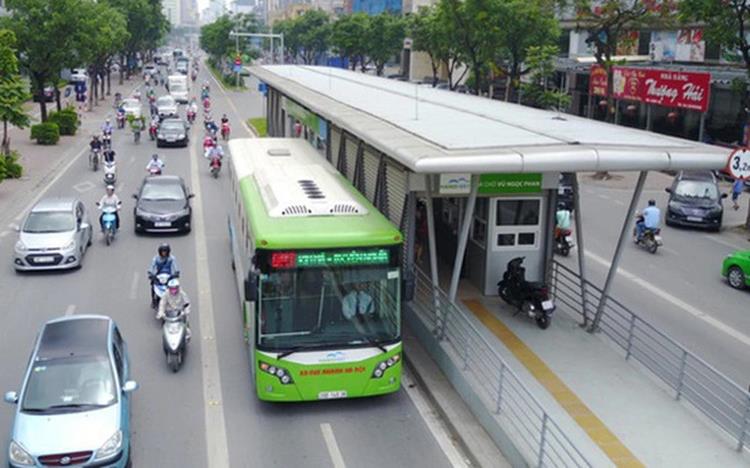Elevated BRT system proposed for Ho Chi Minh City

As Ho Chi Minh City grapples with growing traffic congestion and delays in urban rail development, the city should turn its attention to elevated bus rapid transit (BRT) systems as a faster, more practical solution.
Unlike traditional BRT models constrained by narrow city streets, elevated BRT routes could bypass ground-level traffic, offering a modern, cost-effective alternative for mass transit while easing the city's long-standing transportation woes.
BRT is a form of public transportation that uses buses operating on dedicated lanes along urban roads.
First introduced globally in the 1990s, BRT systems are highly effective when certain technical infrastructure conditions are met: wide exclusive lanes, no level crossings, uninterrupted travel free from traffic signals, routes extending several kilometers, and passenger stations that do not require crossing streets.
In Asia, Jakarta in Indonesia is one of the few cities where BRT has seen relative success, with over 132km of dedicated lanes. However, no further expansion of the system has taken place in Jakarta since.
Vietnams first BRT route was launched in Hanoi in 2017, covering the 15km Yen Nghia-Kim Ma route with a total investment of approximately US$55 million.
However, after just five years in operation, the BRT route exposed numerous shortcomings, proving ineffective, and is now largely seen as defunct.
It is widely recognized that Ho Chi Minh City urgently needs a rapid transit solution to address chronic traffic congestion. Given that the development of an urban rail system within the next 1015 years is unlikely, implementing a BRT system remains a viable short-term solution.
However, establishing dedicated BRT lanes in Ho Chi Minh City presents significant challenges. While implementing BRT on roads like Pham Van Dong, Nguyen Van Linh, or in Can Gio would be relatively straightforward, the real need lies in the inner-city wards where traffic congestion is most severe.
BRT lanes are typically placed in the center of a road, flanked by lanes for motorbikes, cars, and pedestrians. However, in densely populated urban areas of Hanoi and Ho Chi Minh City, the roads are too narrow to allocate a central third of the roadway for BRT use.
Given these limitations, many experts suggested that an elevated BRT or monorail system, like those seen in Chongqing, Dubai, and several other cities, would be a more feasible solution.
As part of the former Ho Chi Minh City's transport development plan through 2030, the Department of Transport has proposed several elevated road projects.
These include the 11.2km Truong Chinh-Cong Hoa route connecting An Suong Intersection to the Tan Son Nhat International Airport area, with an investment of nearly VND12 trillion ($456.4 million); two 2km routes along Xo Viet Nghe Tinh and Dinh Bo Linh Streets connecting to National Highway 13; and a 5.9km route from Binh Trieu Bridge to the border with the former Binh Duong Province, with an estimated investment of VND13.85 trillion ($526.7 million).
Some private companies have also proposed build-operate-transfer projects to construct elevated routes, such as a 30km elevated light rail line running along the Nhieu Loc-Thi Nghe Canal, Saigon River, Ben Nghe Canal, Tan Hoa-Lo Gom Canal, and Lac Long Quan Street.
If these proposals are successfully implemented, the city could have nearly 60km of elevated roads. The total investment would not exceed that of a BRT system, yet would offer a more durable and sustainable solution for a modern city.
With current construction technologies and new materials, elevated infrastructure can be built faster, require less land, and cause minimal disruption to residents.
Combined with modern lighting and architectural design, these elevated roads can be made visually appealing and modern.
Anyone who has visited Dubai or cities like Tianjin and Hubei in China will recognize how elegant and advanced their elevated road systems are.
* This article was originally written in Vietnamese by Dr. Nguyen Minh Hoa and rewritten in English by Tuoi Tre News.
Tuoi Tre News
(2025/08/19-17:59)
To read a full story, please click here to find out how to subscribe.
Tuoi Tre
- 08/19 17:59 Elevated BRT system proposed for Ho Chi Minh City
- 08/19 17:53 Public debate erupts over pet ban in Vietnam's restaurants
- 08/18 18:12 Ho Chi Minh City plans to establish 4 free trade zones
- 08/18 18:02 Dolphins delight visitors in Vietnam's Cam Ranh waters
- 08/18 11:04 Hanoi promotes tourism at Expo 2025 in Japan
- 08/18 10:55 Ho Chi Minh City metro line adds more trips, extends operating hours on weekends
- 08/18 10:51 Vietnam's new regulation on work permits for foreigners expected to attract experts
- 08/18 10:44 Caution urged against hastily shifting flights from Tan Son Nhat airport to Long Thanh airport
- 08/15 17:23 US human rights report based on unverified information: Vietnam’s foreign ministry
- 08/15 17:20 Vietnamese Party General Secretary To Lam, Cambodian People's Party President Hun Sen pledge stronger Vietnam-Cambodia ties
- 08/15 17:17 Vietnamese banks cut nearly 3,000 jobs amid AI adoption
- 08/14 18:12 Vietnam ranks third globally in electric motorbike consumption
- 08/14 18:07 Vietnam fisherman rescued after 24 hours adrift on foam board
- 08/13 17:41 Ho Chi Minh City river clean-up group to roll out trash-collecting robots to cut manual labor
- 08/13 17:36 Gift market bustling ahead of Vietnam’s National Day
- 08/12 18:18 Vietnam Motor Show canceled for 2025 amid sluggish market: organizers













